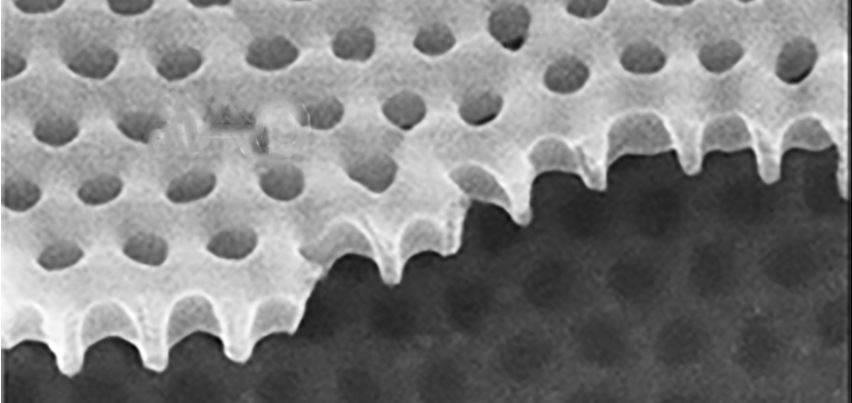Nov 15 2019
Cooper pairs are electron pairs that allow superconductors to conduct electricity without any resistance. For a long time, physicists have thought that these pairs were two-trick ponies, which either glide freely, producing a superconducting state, or form an insulating state by being restricted inside a material, unable to move.
 Tiny holes punched into a high-temperature superconducting material revealed that Cooper pairs, electron duos that enable superconductivity, can also conduct electricity the way metals do. Image Credit: Brown University.
Tiny holes punched into a high-temperature superconducting material revealed that Cooper pairs, electron duos that enable superconductivity, can also conduct electricity the way metals do. Image Credit: Brown University.
However, in a new study reported in Science, a research team has demonstrated that Cooper pairs can also conduct electricity with a specific amount of resistance, similar to how regular metals behave. According to the researchers, the study outcomes illustrate a completely new state of matter, which will need a new theoretical explanation.
There had been evidence that this metallic state would arise in thin film superconductors as they were cooled down toward their superconducting temperature, but whether or not that state involved Cooper pairs was an open question.
Jim Valles, Study Corresponding Author and Professor of Physics, Brown University
Valles continued, “We’ve developed a technique that enables us to test that question and we showed that, indeed, Cooper pairs are responsible for transporting charge in this metallic state. What’s interesting is that no one is quite sure at a fundamental level how they do that, so this finding will require some more theoretical and experimental work to understand exactly what’s happening.”
Cooper pairs have been named after Leon Cooper, a physics professor at Brown University who won the Nobel Prize in 1972 for characterizing their role in enabling superconductivity. Resistance develops when electrons agitate around in the atomic lattice of a material upon moving. However, when electrons combine together to form Cooper pairs, they transform in a remarkable manner.
Electrons are fermions on their, particles that are governed by the Pauli exclusion principle. This means each electron has a tendency to retain its own quantum state. However, Cooper pairs behave like bosons, which can gladly share the same state. Such a bosonic behavior enables Cooper pairs to synchronize their movements with other sets of Cooper pairs such that the resistance is reduced to zero.
Working together with Jimmy Xu, a Brown engineering and physics professor, in 2007, Valles demonstrated that Cooper pairs could also generate insulating states, apart from superconductivity. In materials that are very thin, instead of moving in unison, the pairs contrive to remain in place, stuck to tiny islands inside a material and unable to move to the next island.
For the latest study, Valles, Xu, and teammates in China sought Cooper pairs in the non-superconducting metallic state. They achieved this by employing a method similar to the one that unraveled Cooper pair insulators.
In this method, a thin-film superconductor—here, a high-temperature superconductor yttrium barium copper oxide (YBCO)—is patterned with arrays of tiny holes. When current passes through the material when a magnetic field acts on it, charge carriers within the material will orbit the holes similar to how water circles a drain.
We can measure the frequency at which these charges circle. In this case, we found that the frequency is consistent with there being two electrons going around at a time instead of just one. So we can conclude that the charge carriers in this state are Cooper pairs and not single electrons.
Jim Valles, Study Corresponding Author and Professor of Physics, Brown University
According to the researchers, the concept that boson-like Cooper pairs lead to this metallic state was surprising, since there exist elements of quantum theory that indicate this should not be possible. Therefore, gaining insights into what was just happening in this state could pave the way for some exciting new physics. However, more research will be needed.
Fortunately, the researchers say, since this phenomenon was observed in a high-temperature superconductor, it will make future studies more viable. YBCO turns superconducting at temperatures of about −181 °C, and the metallic phase begins just above that.
Although this temperature is quite cold, it is considerably warmer compared to other superconductors, which become active at just over absolute zero. Such a higher temperature renders it easier to use spectroscopy and other methods aimed at gaining better insights into what exactly happens in this metallic phase.
According to the team, in the future, it might be feasible to harness this bosonic metal state for innovative types of electronic devices.
The thing about the bosons is that they tend to be in more of a wavelike state than electrons, so we talk about them having a phase and creating interference in much the same way light does. So there might be new modalities for moving charge around in devices by playing with interference between bosons.
Jim Valles, Study Corresponding Author and Professor of Physics, Brown University
However, for the time being, the scientists are glad to have found a new state of matter.
“Science is built on discoveries,” stated Xu, “and it’s great to have discovered something completely new.”